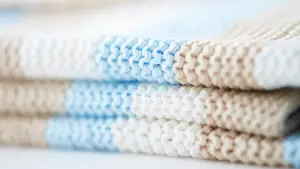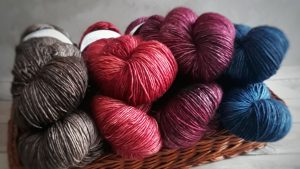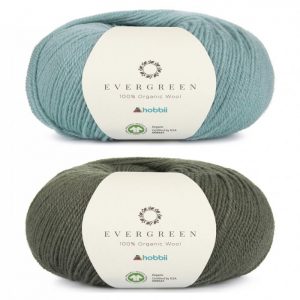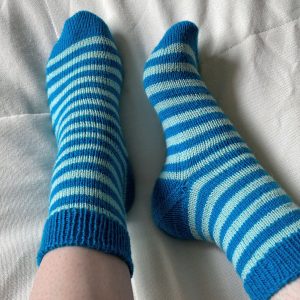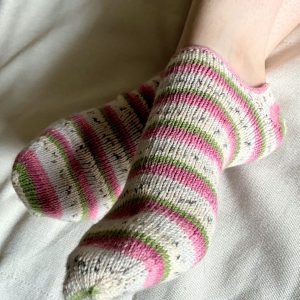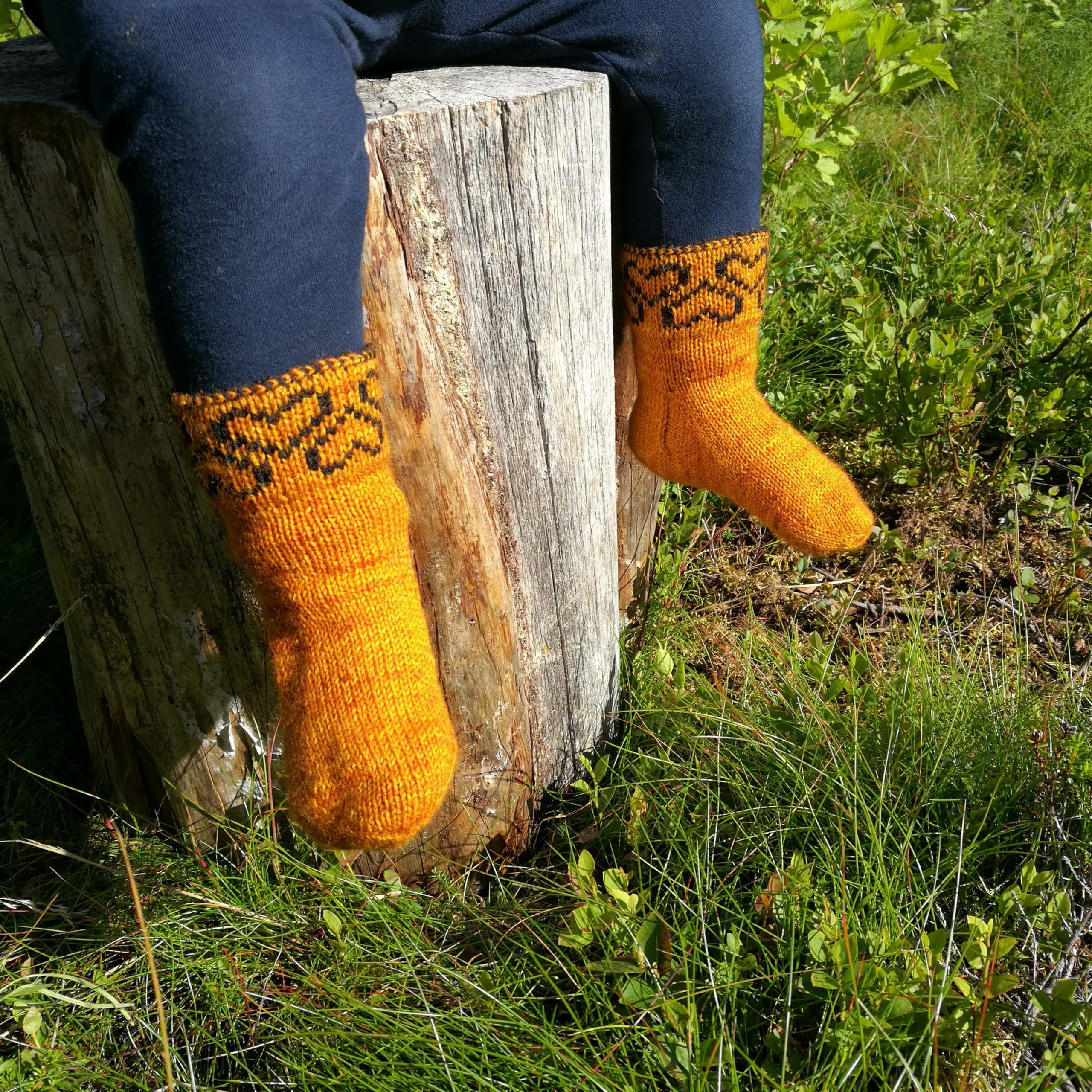Very often I hear people ask “I have fingering weight yarn and US 0 (2 mm) needles, how many stitches should I cast on for US size 13 men’s sock?” Unfortunately without knowing your gauge, the question cannot reliably be answered. That is because our knitting is like our handwriting, very unique. The gauge someone else gets with US 0 needles might be very different than what you get with the exact same needles and yarn.
In the table below are listed the typical stitch counts for adult socks. Your stitch count may be outside the range but the table should give you a rough idea if your calculations sound correct.
| Yarn weight | Stitches for womens sock | Stitches for mens socks |
| Fingering (sock weight) | 56-68 | 68-78 |
| DK | 52-60 | 58-66 |
| Worsted | 44-52 | 48-58 |
Sounds complicated? Don’t worry in this article I guide you through how to get a perfect stitch count for your sock.
If you don’t feel like reading, swatching and making all the math check out my NO swatch, ANY stitch count, ANY yarn sock pattern. It guides you through the sock knitting process so that you get the right amount of stitches without having to calculate a thing for yourself.
Otherwise, if you insist making your socks cuff-down or if you just want to learn some knitting math keep on reading.
To be able to determine how many stitches you need to cast on for your sock you need to first know your gauge and the desired circumference of your sock. First I’ll explain how to figure out those numbers and in the last chapter I give you the formula for the stitch count.
What is gauge in knitting
In knitting, gauge means simply how wide one stitch is. The wider one stitch is, the less you need them to produce a piece of fabric that is for instance 4″ (10 cm) wide. Because it’s tough to measure the width of one stitch accurately, gauge is usually reported in stitches per 4″ / 10 cm or stitches per 1″.
Let’s take an example. If your gauge is 32 sts / 4″ (10 cm) the width of one stitch is 0.125″ (0.313 cm) and you need 32 stitches to produce a piece of fabric that is 4″ wide. If the stitch is narrower, let’s say 0.1″ then you need 40 stitches to produce a piece of fabric that is 4″ wide.
Did you know that it’s very likely that your gauge with certain needles changes over time
Did you know that it’s very likely that your gauge with certain needles changes over time as your technique develops? Usually beginners tend to be tight knitters so they need bigger needles than the average knitter and when time goes by and they become more confident their stitches get looser and they need smaller needles to get the same gauge.
Also the material (plastic, wooden, metal etc.) and the type of the needles (circular, dpns etc.) as well as the yarn (material, yardage, plies) has an effect on the gauge.
How do I know my gauge then?
The only way to know your gauge is to swatch which many people don’t like because the swatches end up being useless (unless you knit your socks toe-up). But getting your gauge right is super important if you want socks that fit well. To get a reliable measurement knit the swatch in the round and make it big enough.
Let’s take an example. I want to make a pair of socks with a circumference of approximately 8″ (20 cm). I usually knit a pair of fingering weight socks with US 0 (2 mm) needles and I get gauge 32 sts / 4″ (10cm). With the previous numbers, I need a total of 8″ / 4″ * 32 = 64 sts for my sock. However, a quick look at Ravelry reveals that quite many people get gauge 36 sts / 4″ (10cm) with that needle size, and to produce a similar sock they would need 8″ / 4″ * 36 = 72 sts.
Now, if I went to Facebook and asked from a person with that much tighter gauge how many stitches should I cast on, the circumference of my sock would end up being 72 / 32 * 4″ = 9″ which is 1″ (2.5 cm) more than I wanted to. That is quite much because that much wider sock would fit perfectly on a foot that is 3 US (6 EU) shoe sizes larger than I wanted to.
How do I know the desired circumference of the sock?
If you are knitting the sock for yourself measure your foot around the ball of your foot, which typically is the largest circumference. Do not include a bunion in this measurement. You should be standing when you measure your foot.
If you are not able to measure the circumference or the length of the foot (for instance because you are going to gift the socks) you can use the foot size chart for sock knitting to determine the foot length and average circumference based on shoe size.
Now that you know the measurements of the foot the sock is going to be knitted for you can calculate the dimensions of your sock. Plain stockinette or ribbed socks should be worn with a little bit of negative ease meaning that the circumference of your sock should be smaller than the circumference of your foot otherwise the sock won’t stay up on the leg. The rule of thumb here is that the sock should have approximately 10% of negative ease. You get this number by multiplying the circumference of your foot with 0.9. Feel free to use the calculator on this page.
The formula for getting the correct stitch count
Now that you know your gauge and the desired circumference of your sock, you can make the calculations and determine the amount of stitches you need to cast on.
If you have measured your gauge in stitches per 4″ use the formula below:
The circumference of your sock / 4 * (stitches per 4″) = total stitch count
For instance, my gauge is 32 stitches / 4″ and I want the circumference of my sock to be 8″ the calculation will be:
8 / 4 * 32 = 64 stitches
Or if you prefer centimeters (8″ = 20cm) and you have measured your gauge in stitches / 10 cm the formula looks like this:
20 / 10 * 32 = 64 stitches
You can measure your gauge also in stitches per any width such as stitches / 2″ (32 sts / 4″ equals 16 sts / 2″) then the formula would be:
8″ / 2 * 16 = 64 stitches



